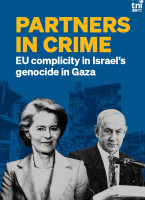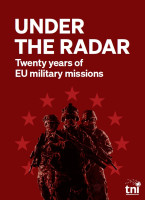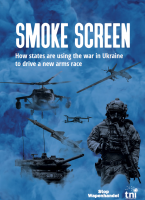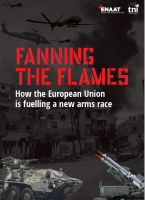The EU is on a War Path
In March 2025, the EU unveiled a €800 billion militarisation plan, framed as “defence readiness”, fuelled by war rhetoric, U.S. alignment, and profit for arms industries. Peace, it seems, is off the table.
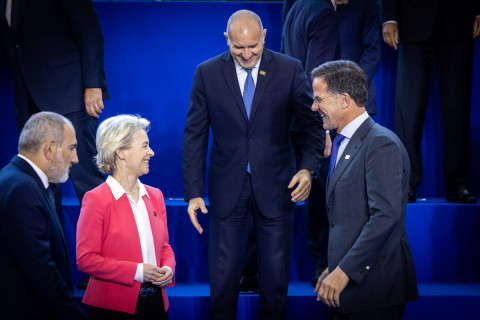
NATO North Atlantic Treaty Organization/Flickr/CC BY-NC-ND 2.0
In March 2025, the European Union (EU) published its White Paper for European Defence Readiness 2030. It begins by stating that ‘Europe faces an acute and growing threat’ and that ‘the only way we can ensure peace is to have the readiness to deter those who would do us harm’. Without providing evidence of the alleged threat, the EU sets out in the following 22 pages what is, in effect, a war plan.
The White Paper describes a ‘rapidly deteriorating strategic context’ citing ‘proximity to North Africa and the Middle East’, which makes Europe ‘a receptacle for the spill-over of the wars, migration and effects of climate change’ in these regions. It also references ‘threats’ from Russia and China. Devoid of any reflection on how EU policies may have contributed to the ‘challenges in the wider European neighbourhood’, the Union frames itself merely as a passive actor that must now respond to this unfortunate situation.
In a nutshell the EU plans to unleash an unprecedented €800 billion to further militarise a massively over- armed region, which alongside European armies, hosts over 40 US military bases and some 84,000 US service personnel. There are also over 600 nuclear warheads dotted around the continent.
EU at the service of US Empire
EU NATO relations were institutionalised in the early 2000s and the White Paper states that NATO is ‘the cornerstone of collective defence of its members in Europe’.
NATO is an offensive war alliance, which operates as a tool of US imperialism and global dominance. By emphasizing the ‘indispensable’ role that NATO will continue to play in EU affairs, the White Paper serves to reassure the US that, far from embarking on an independent foreign policy, the EU will continue being its lapdog.
Perhaps the most telling line in the White Paper is the following: ‘The United States demands that Europe takes more responsibility for its own defence’. So in the service of empire when the US says ‘jump’, the EU says ‘how high?’. As high as €800 billion apparently.
This comes on the heels of a January 2025 address by NATO Secretary General Mark Rutte to the European Parliament where he said that ‘on average, European countries easily spend up to a quarter of their national income on pensions, health and social security systems and we need only a small fraction of that money to make defense much stronger’.
But year on year the combined military spending of NATO members is exorbitantly higher than other states. The 2024 figures show that NATO countries spent $1506 billion (55% global total) compared to China’s $314 billion (12% global total) and Russia’s $149 billion (5.5 % global total).
This immense advantage that NATO has over its rivals on military spending is not enough however. More money is required to counter the ‘acute threat to our way of life’.
A Marketing Strategy for Arms Companies
To ‘achieve full readiness’ by 2030 (whatever ‘full readiness’ means), the EU will ‘reduce red tape’ on spending regulations identifying ‘five pillars to urgently and significantly step up European defence spending’:
(1) a new, dedicated financial instrument to support Member States’ defence investments will be created,
(2) the National Escape Clause of the Stability and Growth Pact will be activated,
(3) existing EU instruments will be made more flexible to allow greater defence investment,
(4) the scope for contributions from the European Investment Bank will be widened, and
(5) private capital will be mobilised.
EU member states currently face multiple challenges following years of privatisation and austerity that have played out in varying degrees across the Union crippling public health systems and social services. Europe is also vulnerable to climate change and frequently experiences extreme weather events. Despite the actual threat from real events resulting from a lack of public investment, the EU has chosen to respond to a hypothetical threat with massive public investment. In doing so its actions will likely exacerbate rather than alleviate the multiple crises the Union is facing.
‘Readiness 2030’ boils down to the EU stretching to breaking point the Union’s legal and fiscal measures to hand over hundreds of billions of public money to private arms companies. It is unsurprising then that a key component of the plan is a ‘strategic dialogue with the defence industry’. Funding will go to the research, development and procurement of air and missile defence, artillery systems, ammunition, AI, quantum, cyber and electronic warfare, and other weaponry, as well as to ‘critical transport infrastructure’ to guarantee ‘military mobility for short-notice and large-scale movements of troops and equipment’ across Europe.
Sounding a bit like a broken record, the White Paper sets out that it is ‘imperative that the EU and its member States urgently increase their military assistance to Ukraine’. The €49.6 billion in military assistance so far, as well as the €75.8 billion to support Ukraine’s ‘economic, social, and financial resilience’ and the €17 billion to cater to the needs of Ukrainians in the EU is not enough. More money is needed to keep the war in Ukraine going, demonstrating that the goal was never about ending war but rather about guaranteeing endless war, generating endless profits for war industry, which enjoys a seat at the decision-making table in Brussels.
In the White Paper the EU commends Ukrainian arms companies for their ‘can-do attitude and entrepreneurial spirit’ noting that ‘Ukraine has become the world’s leading defence and technology innovation laboratory’. The war in Ukraine provides the EU with an opportunity for ‘closer cooperation between Ukrainian and European defence industries’ with ‘first hand knowledge transfer on how to best use innovation to achieve military superiority on the battlefield’.
Such is the exuberant tone in respect of Ukraine that the reader would be forgiven for momentarily forgetting that war is abhorrent and that the Ukrainian war has caused hundreds of thousands of deaths with the exact figure unknown and the forced displacement of over 10 million people. These facts were omitted in the ‘Porcupine Strategy’, the title given in the White Paper to the section on Ukraine.
What next?
The EU is clear: ‘However much we may be wistful’ about the post World War II era, ‘we need to accept … that it is not coming back’. From now on the only show in town is international rules-based order - might makes right. International law and diplomacy have been consigned to the dustbin of history. This is hardly surprising since the EU has been openly backing Israel’s genocidal war on Palestine as a matter of policy for the past 18 months.
Nevertheless, the White Paper ends by reassuring the reader that ‘the EU is and remains a peace project’ and then rolls out the usual equally meaningless jargon on ‘values’, ‘resilience’ ‘unity and strength’ calling on the EU and its Member States ‘to rise to this historic challenge’
It’s impossible to know for sure what will eventually transpire as the EU aspires to ‘achieve full readiness’ but one thing is guaranteed – it won’t be peaceful.

